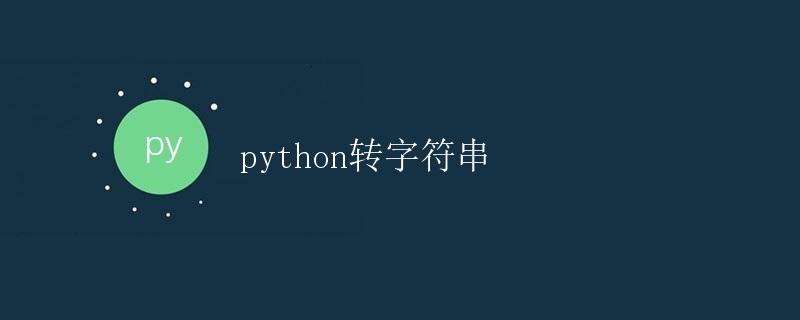Python转字符串

在Python编程中,字符串是一种非常常见的数据类型。字符串可以被认为是由一个或多个字符组成的序列,可以用来表示文本信息。在实际应用中,我们通常会需要将其他类型的数据转换为字符串,或者将字符串转换为其他类型的数据。本文将详细介绍在Python中如何进行字符串转换的操作。
字符串转换为其他数据类型
在Python中,我们可以使用内置的函数来将字符串转换为其他数据类型。下面是常见的几种字符串转换操作示例:
1. 转换为整数
可以使用int()函数将字符串转换为整数。当字符串不包含非数字字符时,转换会成功;否则,将会抛出ValueError异常。
示例代码:
str_num = "123"
int_num = int(str_num)
print(type(int_num)) # 输出:<class 'int'>
print(int_num) # 输出:123
2. 转换为浮点数
可以使用float()函数将字符串转换为浮点数。当字符串不包含非数字字符时,转换会成功;否则,会抛出ValueError异常。
示例代码:
str_num = "3.14"
float_num = float(str_num)
print(type(float_num)) # 输出:<class 'float'>
print(float_num) # 输出:3.14
3. 转换为布尔值
可以使用bool()函数将字符串转换为布尔值。当字符串为空或为”False”时,转换为False;其他情况下,转换为True。
示例代码:
str_true = "True"
bool_true = bool(str_true)
print(type(bool_true)) # 输出:<class 'bool'>
print(bool_true) # 输出:True
str_false = "False"
bool_false = bool(str_false)
print(type(bool_false)) # 输出:<class 'bool'>
print(bool_false) # 输出:False
str_empty = ""
bool_empty = bool(str_empty)
print(bool_empty) # 输出:False
4. 转换为列表
可以使用list()函数将字符串转换为列表。转换后的列表包含字符串中的每个字符作为列表的一个元素。
示例代码:
str_hello = "Hello"
list_hello = list(str_hello)
print(type(list_hello)) # 输出:<class 'list'>
print(list_hello) # 输出:['H', 'e', 'l', 'l', 'o']
5. 转换为元组
可以使用tuple()函数将字符串转换为元组。转换后的元组与转换为列表类似,包含字符串中的每个字符作为元组的一个元素。
示例代码:
str_hello = "Hello"
tuple_hello = tuple(str_hello)
print(type(tuple_hello)) # 输出:<class 'tuple'>
print(tuple_hello) # 输出:('H', 'e', 'l', 'l', 'o')
6. 转换为集合
可以使用set()函数将字符串转换为集合。转换后的集合会去除字符串中的重复字符。
示例代码:
str_hello = "Hello"
set_hello = set(str_hello)
print(type(set_hello)) # 输出:<class 'set'>
print(set_hello) # 输出:{'e', 'H', 'o', 'l'}
其他数据类型转换为字符串
同样地,在Python中也可以将其他类型的数据转换为字符串。下面是几种常见的类型转换示例:
1. 转换整数为字符串
可以使用str()函数将整数转换为字符串。
示例代码:
num_int = 123
str_int = str(num_int)
print(type(str_int)) # 输出:<class 'str'>
print(str_int) # 输出:"123"
2. 转换浮点数为字符串
同样地,使用str()函数可以将浮点数转换为字符串。
示例代码:
num_float = 3.14
str_float = str(num_float)
print(type(str_float)) # 输出:<class 'str'>
print(str_float) # 输出:"3.14"
3. 转换布尔值为字符串
同样地,使用str()函数可以将布尔值转换为字符串。
示例代码:
bool_value = True
str_bool = str(bool_value)
print(type(str_bool)) # 输出:<class 'str'>
print(str_bool) # 输出:"True"
4. 转换列表为字符串
可以使用"".join()将列表的元素连接为一个字符串。
示例代码:
list_hello = ['H', 'e', 'l', 'l', 'o']
str_hello = "".join(list_hello)
print(type(str_hello)) # 输出:<class 'str'>
print(str_hello) # 输出:"Hello"
5. 转换元组为字符串
同样地,可以使用"".join()将元组的元素连接为一个字符串。
示例代码:
tuple_hello = ('H', 'e', 'l', 'l', 'o')
str_hello = "".join(tuple_hello)
print(type(str_hello)) # 输出:<class 'str'>
print(str_hello) # 输出:"Hello"
6. 转换集合为字符串
同样地,可以使用"".join()将集合的元素连接为一个字符串。需要注意的是,集合是无序的,所以连接的结果也是无序的。
示例代码:
set_hello = {'e', 'H', 'o', 'l'}
str_hello = "".join(set_hello)
print(type(str_hello)) # 输出:<class 'str'>
print(str_hello) # 输出:"eloH"
结论
在Python中,我们可以使用内置的函数来实现字符串与其他数据类型的转换。本文介绍了几种常见的转换操作,包括字符串转整数、浮点数、布尔值等,以及其他类型转字符串的操作。根据实际需求,选择合适的转换方法可以使程序更加灵活和高效。
 极客教程
极客教程